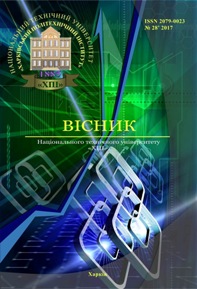An intellectual component recognition for security subsystem
DOI:
https://doi.org/10.20998/2079-0023.2017.28.07Keywords:
recognition system, optimization, machine learning, image, information criterion, functional efficiencyAbstract
Discovered and proved the overall structure of the algorithms used in pattern recognition. A comparative analysis of methods and approaches to solving the problem of finding and identifying human face on the image. A modified algorithm for image scaling and clustering, which reduces the number of informative tracts candidates for the location of the research object (human face) is proposed. It is established that the use of neural networks coagulation makes a small number of errors in a large number of coagulation and other layers. It is established that the network has a large invariance to position the face in the picture. In consequence of that generalization ability higher than the multilayer perceptron. Evaluating the effectiveness of probabilistic systems showed that the use of the proposed approaches and algorithms enables a high probability likely face recognition (93%). Results of the study can be used in the development of automated systems for access: a personal computer, a bank account, application to access data on the image of a human face in miniature devices where there is no possibility to embed common hardware identification.References
Edwards G. J., Cootes T. F., Taylor C. J. Face Recognition Using Active Appearance Models. ECCV’98. Proceedings of the 5th European Conference on Computer Vision. Freiburg, Germany, June 2–6 1998. Vol. II. Heidelberg, Springer Publ., 1998, pp. 581–595.
Golovko V. A. Nejrointellekt: Teorija i primenenija. Kniga 1. Organizacija i obuchenie nejronnyh setej s prjamymi i obratnymi svjazjami [Neurointelligence: Theory and Applications. Book 1. The Organization and Training of Neural Networks with Direct and Reverse Links]. Brest, BPI Publ., 1999. 260 p.
Gultyaeva T. A., Popov A. A. Raspoznavanie lic s ispol'zovaniem skrytyh markovskih modelej [Face Recognition Using Hidden Markov Models]. Nauka. Tehnologii. Innovacii. NTI-2004: Materialy vserossijskoj nauch. konf. mol. uchenyh. Ch. I [Science. Technologies. Innovation. STI-2004: Proceedings of the All-Russian Scientific Conference. Conf. Young scientists. Part I.]. Novosibirsk, Novosibirsk State Technical University Publ., 2004. pp. 159–160.
Haddadnia J., Faez K. Human face Recognition Using Radial Basis Function Neural Network. Proc. of 3rd International Conf. on Hu man and Computer. Aizu, Japan, 6–9 Sept. 2000, pp. 137–142.
Reznik A. M., Kussul' M. Je., Sychev A. S., Sadovaja E. G., Kalina E. A. Sistema proektirovanija modul'nyh nejronnyh setej SAPR MNS [The system design of modular neural networks of the CAD MNS]. Matematichiskie mashiny i sistemy. 2002, no. 3, pp. 28–37.
Downloads
How to Cite
Issue
Section
License
Copyright (c) 2017 Вісник Національного технічного університету «ХПІ». Серія: Системний аналiз, управління та iнформацiйнi технологiїAuthors who publish with this journal agree to the following terms:
- Authors retain copyright and grant the journal right of first publication with the work simultaneously licensed under a Creative Commons Attribution License that allows others to share the work with an acknowledgement of the work's authorship and initial publication in this journal.
- Authors are able to enter into separate, additional contractual arrangements for the non-exclusive distribution of the journal's published version of the work (e.g., post it to an institutional repository or publish it in a book), with an acknowledgement of its initial publication in this journal.
- Authors are permitted and encouraged to post their work online (e.g., in institutional repositories or on their website) prior to and during the submission process, as it can lead to productive exchanges, as well as earlier and greater citation of published work (See The Effect of Open Access).


